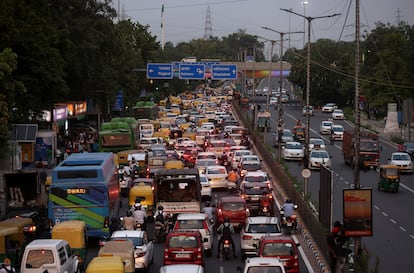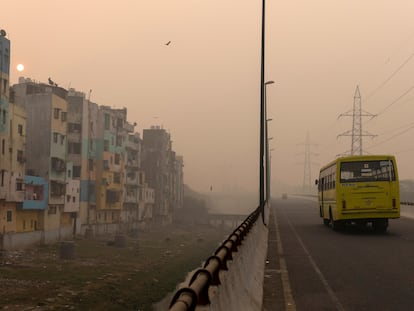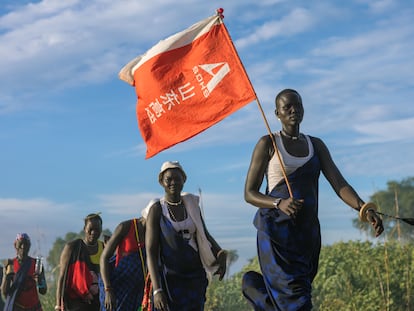Global crises pose threat to developing countries’ green transition, UN says
Only 20% of 95 states analyzed in an agency report have succeeded in reducing poverty levels since 2019, which has been exacerbated by pandemic, debt and the war in Ukraine


Three years of simultaneous crises, resulting from the Covid-19 pandemic, the war in Ukraine and the crushing debt crisis, have compelled most developing countries to scrap or cut back on investments in greener energy or social protection. This is the conclusion of the latest United Nations Development Programme (UNDP) report, published on Tuesday. According to the findings, 75% of the 95 developing nations analyzed have increased their carbon emissions since 2019 — 38 of them by as much as 10% — and only one in five has been successful in reducing poverty levels. “The countries are trapped by the constant pressure to achieve economic growth at all costs,” especially in a situation of “stringent fiscal and financial constraints,” argues the report, which analyzes the progress of the Sustainable Development Goals (SDGs) that should be achieved by 2030 to eradicate poverty and protect the planet.
“The development we want, which is driven by human development, sustainable economic growth and ongoing innovation, is often held hostage to the growth we get through fossil fuels, mineral extraction, high commodity prices and unsustainable debt,” warned UNDP Administrator Achim Steiner during the presentation of the report. The warning comes a week ahead of the United Nations Summit on Sustainable Development, which will be held between September 18 and 19 in New York. At the summit, the UNDP says that it will call for “international action to ensure environmentally sustainable and inclusive economic growth.” “This will not be accomplished through trickle-down economics or a quick fix. It will take an overhaul of the international financial architecture and domestic policies to allow countries to better align their fiscal and financial resources with the SDGs,” added Steiner.
In developing countries, growth driven by fossil fuels continues to accelerate. In countries such as Mongolia, the Democratic Republic of Congo and Tajikistan, emissions of toxic gases are on the rise at annual rates ranging from 11.5% to 12%, according to UNDP data. In others, like Sri Lanka, Malawi or Namibia, the increases are considerably smaller, below 1%.
Poverty rates have also failed to improve — in 80% of the 95 countries studied, the poverty rate has either gone up or remained the same. Some of the most striking examples are Haiti, Chad and Gambia, where the percentage of the population currently living below the poverty line, on less than $2.15 (about €2) a day, has increased by more than 5%. “In 2015 [the year the U.N. adopted the SDGs], we did not have to contemplate a pandemic, wars or a world where financial markets were in a situation like that of the present day,” explained Steiner to stress the difficulty of achieving the goals of constructing a more prosperous and sustainable world by 2030.
According to the UNDP, excessive debt is one of the major obstacles to the achievement of the SDGs. In 2022, “developing countries paid $400 billion [€373,295 million] in interest on public debt,” while they received $473 billion in credits from various international organizations, Steiner pointed out. He warned that a total of 52 developing economies are heavily indebted or at risk of having high debt levels, and if forecasts do not change, “50 countries will spend more than 10% of their income to pay their debts this year.” The result of this situation is that “economies will spend 2.3 times more on debt than on social assistance and 1.4 times more than on health spending,” according to the U.N. agency’s global data.
The picture is particularly alarming in countries where debt amounts to more than 100% of GDP, such as Sri Lanka (117.7%), Zambia (110.8%) and the Maldives (108.9%). In addition, “Sri Lanka, Ghana and Zambia have defaulted on their debts and have consequently lost access to international capital markets,” the UNDP notes.
Solutions
However, the U.N. agency believes there is a silver lining and dismisses the claim that there is no “trade-off between poverty and climate,” as evidenced by the examples of some countries. But this requires “institutional effectiveness, functioning justice systems and solid governance,” it noted. Indeed, the report, which analyzes each developing country on an individual basis, is intended to serve as a “handbook” of policies that contribute to fighting poverty and building a more just world. “By focusing on things happening at the national level, our analysis reveals that national government priorities, such as jobs, infrastructure, cities and institutions, can fuel a broader realignment of social, environmental and economic progress; but to do so, these priorities must be tied to specific combinations of SDGs,” stresses Laurel Patterson, UNDP Director for SDG Integration. This choice of policies for sustainable development is what “could change growth patterns.”
The agency highlights cases like those of Egypt and Zambia, which have put “decent work” at the center of their policies, a priority for development and a goal of the 2030 Agenda, with policies including “promoting inclusion, empowering youth and creating opportunities for women.” According to the U.N. agency, such initiatives in turn have an impact on other SDGs, such as ending poverty, gender equality and reducing inequalities.
The same applies to the commitment to “resilient infrastructure and sustainable cities,” particularly in the Asia-Pacific regions, where the policies in place also have an impact on other objectives such as climate. One example of this is Bhutan, which, in order to combat accelerating urbanization that exacerbates the risk to populations in the face of severe weather conditions, has opted for the development of sustainable cities, with “climate-sensitive urban planning and investments in green infrastructure.” “This approach yields poverty-climate win-win benefits,” said the UNDP.
Sign up for our weekly newsletter to get more English-language news coverage from EL PAÍS USA Edition
Tu suscripción se está usando en otro dispositivo
¿Quieres añadir otro usuario a tu suscripción?
Si continúas leyendo en este dispositivo, no se podrá leer en el otro.
FlechaTu suscripción se está usando en otro dispositivo y solo puedes acceder a EL PAÍS desde un dispositivo a la vez.
Si quieres compartir tu cuenta, cambia tu suscripción a la modalidad Premium, así podrás añadir otro usuario. Cada uno accederá con su propia cuenta de email, lo que os permitirá personalizar vuestra experiencia en EL PAÍS.
¿Tienes una suscripción de empresa? Accede aquí para contratar más cuentas.
En el caso de no saber quién está usando tu cuenta, te recomendamos cambiar tu contraseña aquí.
Si decides continuar compartiendo tu cuenta, este mensaje se mostrará en tu dispositivo y en el de la otra persona que está usando tu cuenta de forma indefinida, afectando a tu experiencia de lectura. Puedes consultar aquí los términos y condiciones de la suscripción digital.










































